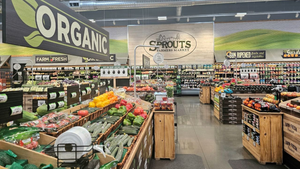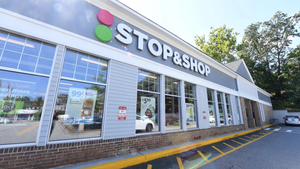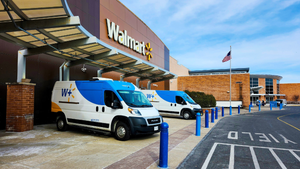It’s a new scene for grocery shopping as pandemic changes behaviorsIt’s a new scene for grocery shopping as pandemic changes behaviors
COVID-19 brought ‘unprecedented disruption’ to food retailing and consumption, FMI study finds
June 12, 2020

The arrival of coronavirus in the United States upended Americans’ grocery shopping habits, triggering more store visits and online purchases as consumers tried new ways of shopping and shifted to eating at home, according to the FMI-The Food Industry Association’s annual U.S. Grocery Shopper Trends study.
Before the COVID-19 pandemic, U.S. grocery shopping kept to a familiar pattern, noted FMI’s report, prepared by The Hartman Group and released this week. Household food shopping frequency has remained high, at 2.7 trips weekly, and customers use several retail channels (4.1) and store banners (5.0) to meet their monthly grocery needs. But in the early weeks of the outbreak, weekly grocery trips by households jumped to 3.6, and 40% of shoppers said they were shopping fewer stores for groceries.
“Never before in the recent past of our nation have we been forced to confront the magnitude of abrupt changes that COVID-19 circumstances foisted upon us all,” David Fikes, executive director of the FMI Foundation, said in a webinar Wednesday on the U.S. Grocery Shopper Trends study. “So the food industry — an industry that over the past few decades has become quite accustomed to confronting and addressing disruptions — suddenly found itself facing an unprecedented disruption.”
In March, when President Trump declared coronavirus a national emergency, food retail revenue soared over 25% from February, “collapsing more than eight years of dollar growth into a few tumultuous weeks,” FMI said in the report. As of April, food retail revenue remained more than 10% higher than pre-pandemic levels.
Shoppers exceeded their previous weekly household grocery budgets by an average of 33% to stock up for lockdowns, the study said. The weekly household grocery bill surged from around $120 to $161 between March 21 and April 2, before moderating to $130 through April 25.
The retail surge also reversed long-term food spending trends, in which food retail had gradually declined since the early 1990s as foodservice crept up. Food retail’s share of food spending rose from 50% in February to 63% in March and then 68% in April, returning to levels not seen since the early to mid-1990s, according to the study. Meanwhile, restaurants — forced to close or offer only takeout and/or delivery — saw their share of food retail spending drop from around 50% to roughly 35%.
‘Where, How and Who’ of grocery shopping changes
As a result of the coronavirus crisis, 78% of shoppers surveyed said they made a change in where they shop for food. Forty percent shopped at fewer stores, and 28% shop more online. Also, 15% said they avoid stores they typically shop, 11% changed the store they shop most often, 10% shop at different types of stores, and another 10% have stopped going to stores.

“At first, people were multisourcing as they stocked up and were trying new things. Now they’ve settled into more of a routine,” David Feit, vice president of strategic insights at The Hartman Group, said in the webinar. “Relatively few people say that they no longer shop in-store at all.”
Besides changing where they shop, Americans also have changed how they shop, Feit pointed out. Nearly nine in 10 respondents (89%) said they shop differently because of COVID-19. Changes include 44% spending more money on each visit, 32% speeding up shopping trips, 25% narrowing the range of items purchased, and 16% spending more money online.
“They’re making more efforts to minimize the number of trips,” Feit said. “It’s probably a mistake to consider these neatly as stock-up trips, because from the shopper’s perspective it’s a break from the rhythms of stock-up and fill-in, fill-in, fill-in. It’s more like going out of their way to avoid the fill-in trips and getting it all done at once. Overall, the picture we have is a very functional, planful, directed shopping — not at all the exploratory mode of browsing and deciding.”
And who makes the grocery shopping trip is different for many households as well. Of consumers polled, 36% have made a change in who shops for food because of COVID-19, the FMI study revealed. Among the changes, 24% said just one person now shops for groceries versus two or more people previously, while 11% report that someone outside the household, such as a relative or friend, makes the shopping trip. Three percent said a different person in their household now does the food shopping.
“There are now two people in the household who have opinions and shopping preferences, but there’s only one opportunity to go into the store,” Feit said. “This has likely led to list-building collaborations in households, where that hadn’t been quite as routine as before.”

‘Unmistakable’ upsurge in online grocery
Researchers said FMI already had been tracking an upward trend in online grocery purchases well before the pandemic. But the need for social distancing following the coronavirus outbreak has led grocery shoppers to avoid store trips and turn increasingly to digital channels to select and pay for their food.
“The magnitude of the change here is unmistakable,” the FMI study said. “While direct reporting of sales will eventually provide a more precise picture, the amount of grocery dollars going to online transactions likely doubled in April compared to what it would have been.”

In 2019, online grocery accounted for 10.5% of U.S. consumers’ total weekly grocery spending. But that climbed to 14.5% in February and then jumped to 27.9% for March and April.
Of those surveyed, 49% had shopped online in the past month, including 21% doing so for the first time and 8% returning to online shopping because of the COVID-19 crisis. Many reported using specific order methods for the first time, including curbside pickup, while others said they bought perishables online for the first time, which has previously been a key obstacle for a fuller online food shopping basket. Forty percent or more first-time online shoppers said they purchased milk (45%), dairy (43%), bakery (43%), deli (41%), frozen (41%) and fresh produce (40%). Also, 39% bought bread, and 38% purchased meat and/or seafood.
“The proportion of shoppers shopping for grocery-type items online in the past month has increased to almost one-half of Americans. This is more than twice the proportion of monthly online shoppers compared to what we have seen about one year ago,” FMI Director of Research Steve Markenson said in the webinar. “And not only are there more online shoppers, but these online shoppers are shopping more frequently and are spending more. Many shoppers are trying online shopping for the first time since the beginning of the pandemic.”

In terms of fulfillment, 18% of online grocery shoppers (including 8% of first-timers) are opting for same- or next-day delivery, compared 16% (including 9% of first-timers) for curbside pickup and 14% (including 7% of first-timers) for in-store pickup. Seventeen percent (including 5% of first-timers) choose home delivery with standard shipping, and 8% (including 4% of first-timers) subscribe for ongoing deliveries.
“The first time online shoppers tend to show greater propensity for pickup options, including curbside or in-store pickup,” Markenson said.
Skyrocketing online grocery orders amid the pandemic have made it tougher for retailers and e-commerce providers to keep up, leading customers to try multiple fulfillment options or go to other retailers.
“For some, it may have to do with choosing the options that give them what they want, when they need it or, quite honestly, as soon as possible,” said Markenson. “Many companies are struggling to meet this high demand, whether it be for home delivery or click-and-collect.”
Eight-four percent of respondents reported problems with online grocery shopping, namely in terms of inventory and fulfillment. Out-of-stocks issues cited by customers include paper products (43%), preferred foods (43%), limited quantities (43%) and other items (42%). Also, 40% encountered delays after ordering or no acceptable times for home delivery (20%) or pickup (19%).
“Not everyone will continue to be ordering online at the current level,” Markenson added. “But many shoppers now have online in their grocery shopping portfolio and will likely be using it more than they did before this pandemic.”
Back to the home
Before the virus hit U.S. shores, 90% of grocery shoppers reported dining out sometimes. But FMI said that during March and April, just 45% said they used restaurant delivery, and 35% indicated cooking at home six to seven days a week.
According to the study, 87% of all families consider eating together as important, and the COVID-19 crisis has amplified that view. Of survey respondents, 41% report cooking more of their meals since the pandemic, and 42% are minimizing trips to the store.
In cooking more frequently at home, 27% of consumers are planning more meals in advance, and 20% are trying new dishes more often. or using perishables before they spoil. Similarly, 44% prioritize using perishable foods before they spoil, and 36% said they’ve adopted healthier eating habits.
“In a world where eating out is suddenly off the table, what are Americans doing and what are they thinking?” Feit said. “The habits disrupted here and the habits learned here may become the most important drivers of long term change in food spending once social distancing restrictions ease to a greater or lesser extent.”
Going forward
Still, the severe economic impact that COVID-19 has wrought nationwide has many households worried about their ability to feed their families.
FMI’s study found that 20% of shoppers aren’t sure if they will have enough money to pay for food, and half are extremely concerned (25%) or somewhat concerned (25%) about having enough food for their household.
What’s more, consumers have worries about returning to their normal in-store shopping regimens. Of potential concerns, 70% of shoppers cited becoming ill, 57% named out-of-stock items and 38% said rising prices.

Respondents noted that they would be more likely to use a food retailer that sanitizes stores, carts and checkout (cited by 78%); limits the number of shoppers in stores (38%); offers special hours (33%); reduces employee handling of food (32%); and provides a steady supply of fresh produce and meat (30%).
So far, customers seem satisfied with grocery retailer’s COVID-19 safety and operational measures. Through late April, on a scale of 1 to 10, 73% of shoppers rated their primary store’s response to the pandemic an 8 to 10, while 24% rated it at 4 to 7.
“In looking toward the future, most consumers expect to return to their pre-pandemic levels of in-store grocery shopping and more than a fourth of consumers expect to be ordering more groceries online in the future,” FMI President and CEO Leslie Sarasin, said in a statement. “The food industry will continue to listen to consumers and let them guide us on how to best meet their changing household needs. Whatever comes next, we know the supply chain is tremendously resilient and that we can flex, pivot and accommodate the demands of the nation’s grocery shoppers.”
The COVID-19 impact research in the U.S. Grocery Shopper Trends 2020 report reflects surveys of more than 2,000 U.S. adults from Feb. 7 to 27 and four waves of tracker surveys of about 1,000 U.S. adults, covering March 21 to 26, March 28 to April 2, April 4 to 9 and April 15 to 25.
For our most up-to-date coverage, visit the coronavirus homepage.
About the Author
You May Also Like


.webp?width=300&auto=webp&quality=80&disable=upscale)



